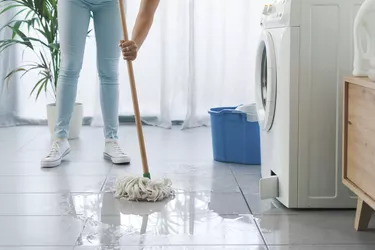
If you have State Farm homeowners insurance, it will protect you from some types of water damage. And you'll be glad it does: Water damage is among the top five most expensive home repairs, The Zebra says, costing an average of about $2,300 per incident. While the company will not pay for damage from floods caused by rain and storms, other types of water damage are covered under State Farm's water damage coverage.
State Farm's Plumbing Coverage Has Limits
Video of the Day
One of the most common types of water damage occurs after indoor pipes freeze and burst. When this happens, it can damage your flooring, walls, furniture, computers and anything and everything else in the water's path. You will have to pay the deductible on your policy, but State Farm has a good reputation in the industry for paying for water damage caused by frozen pipe bursts as long as "reasonable care is used to maintain heat in the home," the company says. In other words, if the temperature in a home is found to be a contributing factor in why the pipes froze and burst in the first place, the claim may be denied.
Video of the Day
The company draws a similar distinction with roof leaks, so you'll want to consult the specifics of your State Farm home insurance water damage coverage. As a general rule, water damage that ensues because a homeowner has neglected to maintain his home is not covered by the company. So if your roof leaks after a storm and the water entered your home through a skylight crack that has clearly and slowly deteriorated over time, the damage will not be covered.
State Farm Water Damage Coverage “Typically” Covers Ice Dams
This said, if water rushes into your home because part of your roof is torn off during a tornado, any resulting damage should be covered.
So should damage from ice dams, which State Farm says are "typically covered." Ice dams form at the edge of a roof when water (and often, snow) pools and then freezes, creating a heavy block of ice, the University of Minnesota Extension says. Eventually, when the weather turns warmer or the sun shines, the water and melted snow lodged behind the ice dam have nowhere to go; they're blocked by the dam.
As a result, water can seep into a home, though "seep" may be an understatement: The scene can resemble a waterfall, with water streaming downward, hard and fast, and damaging walls, ceilings, insulation and floors. The water can even enter electrical outlets and cause an outage.
Maintenance Makes the Difference
State Farm's plumbing coverage can extend to water damage caused by a leaking water heater, dishwasher or washing machine - as long as a lack of maintenance isn't a contributing factor.
This recurring theme – maintenance – points up the wisdom in hiring a plumber to inspect every indoor pipe as well as the hoses coming from your water heater, dishwasher, washing machine and even your refrigerator. You can count on a claims adjuster inspecting the source of the water damage with great care. And one badly corroded pipe could mean the difference between damage that you will be fully compensated for and a claim that registers only an expression of empathy for the mess and expense.
To minimize both, and to prevent mold and mildew from growing, William Henderson Plumbing recommends soaking up the water as soon as possible. Use mops or a wet vac and then fans to dry out the area completely. If you need to call for outside help, be sure to save your receipts; you'll need them for your State Farm claim.